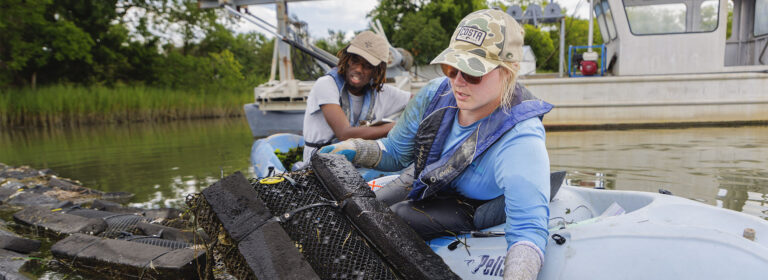Community science shows ‘intricate pattern’ of carryover effects for oysters
Chris Conley and Miles Wong grow thousands of oysters off their dock in the York River each year — but this year, they grew another 50 oysters as part of a community science project.
The oysters are part of Graduate Research Fellow Annie Schatz’s research project, which investigates how stressful water conditions affect oysters. Her project tracks oysters across their lifespan — from the time they’re tiny, free-swimming larvae, to the first few months of their lives after they’ve settled and attached to a hard surface.
“As we start to know more, part of that is understanding that organisms’ lifecycles aren’t separate, and they all flow one into the next,” Schatz said.
In the first few weeks of an oyster’s life, poor water quality can cause slower growth or even death. Even for hardier adult oysters, acidic water weakens their shells and stunts their growth. Schatz, a Ph.D. candidate at the Virginia Institute of Marine Science, is interested in the way stress from an oyster’s first weeks of life might impact its health later on — a phenomenon called carryover effects.
To study carryover effects, Schatz raised larval oysters under stressful conditions replicated in tanks containing either acidic water, or warmer water. Then, she put the oysters in aquaculture cages so they could continue growing in the Rappahannock and York Rivers.
“In a lab setting, we try to control as much as we can environmentally, because we are trying to isolate the effects of ocean acidification and temperature,” Schatz said. “That is not how it works in the natural environment.”
An oyster’s life beyond the lab
In addition to her own two test sites, Schatz worked with six volunteers from the Tidewater Oyster Gardeners Association, including Conley and Wong. The volunteers provided additional sites where the oysters could grow in along the Rappahannock and York Rivers.
“The whole purpose was to try to expand to as many environmentally relevant ranges that we know oysters live in, and see how those carryover effects may manifest in natural settings,” Schatz said.
The volunteers measured how much each of the 50 oysters had grown monthly, and recorded the water temperature and pH. Since half these oysters had been grown in acidic water during their larval stage, and half of them were raised in typical water conditions, any differences between the two groups could indicate carryover effects.
For Oyster Gardeners Wong and Conley, who participate in several community science projects, this project was a chance to contribute to science about the oysters they’ve always loved to eat. The couple began growing oysters shortly after they moved to Virginia more than a decade ago.
“We were like, ‘Oh, we can grow our own?’ So we bought some cages and bought some oysters,” Conley said. “It’s pretty easy animal husbandry — you don’t have to feed them.”
Later, as they became master oyster gardeners and joined the Tidewater Oyster Gardeners Association, that they learned how oysters filter the water as they feed and improve water quality in the Bay.
“When we grow oysters off the dock, they create an ecosystem with different varieties of organisms that live around it,” Wong said. “Before we moved here, this place was a desolate swamp. But now I see a lot more life, little fishes everywhere. It didn’t have that before.”
“The whole purpose was to try to expand to as many environmentally relevant ranges that we know oysters live in, and see how those carryover effects may manifest in natural settings,” Schatz said.
Oyster Gardeners Wong and Conley began growing oysters shortly after they moved to Virginia more than a decade ago.
Community results show an ‘intricate pattern’ of carryover effects
In addition to the oysters grown by the six volunteers, Schatz kept some of these oysters to monitor herself and run more detailed tests. As she measured oyster growth, stress from acidic conditions early on didn’t seem to affect the oysters’ growth later in either river.
But the growth results from the oyster gardeners painted a different picture: In the saltier parts of the river, the oysters that were exposed to acidic conditions didn’t grow as well. In the less salty parts of the river, the oysters that were exposed to acidic water actually grew better.
“My volunteers found a really intricate pattern with their oysters, and definitely something I wouldn’t have seen with just my own growth results,” Schatz said.
Growth measurements aren’t the only thing the oyster gardeners have given Schatz. She doesn’t eat oysters — she doesn’t like the smell of the shell baking — but Conley and Wong shared an oysters Rockefeller recipe she enjoyed.
Measuring oyster stress
The clearest sign of carryover effects is oyster growth.
“That’s like their outward expression of stress. If they’re not growing as fast or as big, then something may be occurring,” Schatz said.
But an oyster’s cells can show signs of stress too. Back in the lab, Schatz conducted more detailed tests on some of the oysters. She measured the total amount of protein in the oysters — a way to get more details about their growth.
She also measured how many antioxidants the oyster produced. Antioxidants counteract the of destructive molecules that are created when the cells are stressed. Higher levels of antioxidants are a clue that the oyster might be experiencing higher levels of stress. Without antioxidants, the destructive molecules damage the proteins and DNA in the cell.
“You can look at the antioxidants, but you can also look at the damage that happens,” Schatz said.
A rocky start may result in more resilient oysters
Schatz’s early results show that oysters exposed to acidic conditions in the earliest weeks of life may actually be hardier as they get older, and have a better ability to handle stress later on. Although it’s too early to draw any hard conclusions about carryover effects, working with the oyster growers gave Schatz motivation to analyze the results, even when her day-to-day work feels mundane.
“Some of them have had issues at their sites that they’re curious about, and so that’s why they’re excited to take part in this project — maybe it does have something to do with the acidification levels,” Schatz said. “Having their perspective definitely helps keep me motivated to figure things out for them.”
Takeaways:
- Annie Schatz, a Ph.D. candidate at the Virginia Institute of Marine Science, is interested in the way stress from an oyster’s first weeks of life might impact its health later on — a phenomenon called carryover effects.
- To study carryover effects, Schatz raised larval oysters under stressful conditions replicated in tanks containing either acidic water, or warmer water. Then, she put the oysters in aquaculture cages in the Rappahannock and York Rivers.
- Schatz’s early results show that oysters exposed to acidic conditions in the earliest weeks of life may actually be hardier as they get older, and have a better ability to handle stress later on — results she saw while collaborating with local oyster growers to test her oysters at additional sites.
Photos by Aileen Devlin and Lisa Sadler | Virginia Sea Grant
Video by Aileen Devlin | Virginia Sea Grant
Story by Madeleine Jepsen | Virginia Sea Grant
Published April 26, 2022.
“My volunteers found a really intricate pattern with their oysters, and definitely something I wouldn’t have seen with just my own growth results,” Schatz said.





